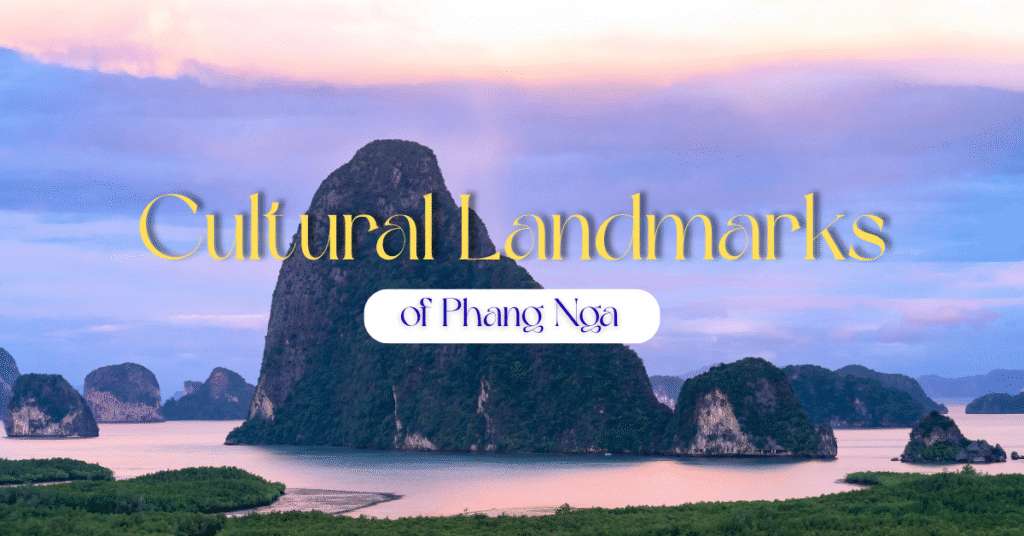Phang Nga is not only famous for its beautiful seas, clear waters, white sandy beaches, and iconic islands but also home to many cultural landmarks that tell the stories of its people, lifestyle, and artistic heritage. These places reflect the deep cultural roots of the province and offer visitors meaningful experiences beyond natural attractions.
1. Wat Suwan Khuha (Cave Temple)
One of the must-visit landmarks is Wat Suwan Khuha, commonly known as the “Cave Temple,” located in Takua Thung District. Inside the large cave lies a reclining Buddha image over 15 meters long, creating a sacred and serene atmosphere.
The temple also features ancient wall paintings and stunning stalactites and stalagmites, blending spirituality with natural beauty.
Highlights for Visitors
-
Perfect for those interested in religion and art
-
A learning spot for local history
-
Unique cave photography opportunities
2. Sala Por Pu Thao Maha Phrom (Sa Ra Ngeng)
Another important landmark is Sala Por Pu Thao Maha Phrom (Sa Ra Ngeng), Phang Nga’s city pillar shrine. Locals deeply respect this site, which blends Thai and Chinese architectural styles.
It is a spiritual center where rituals and ceremonies are held. Visitors often stop by to pay respects and seek blessings for good fortune.
3. Takua Pa Old Town
Phang Nga’s Takua Pa Old Town is a cultural gem, showcasing rows of colorful Sino-Portuguese buildings, similar to those in Phuket and Penang.
The streets are lined with coffee shops, local restaurants, and small museums that preserve the area’s mining-era stories. Walking through the district feels like stepping back into the golden age of the tin-mining industry.
Things to Do
-
Take photos of the Sino-Portuguese architecture
-
Enjoy coffee in charming vintage cafés
-
Visit the Takua Pa community museum
4. Guan Yin Shrine (Ko Tapu)
Phang Nga is a melting pot of Thai, Chinese, and Muslim communities. One spiritual highlight is the Guan Yin Shrine, located near Ko Tapu (James Bond Island).
This shrine is especially revered by the Chinese community. Travelers come here to pray for health, happiness, and success while enjoying panoramic sea and mountain views.
5. Phang Nga City Museum
For those eager to dive deeper into the province’s history, the Phang Nga City Museum is the perfect place.
It presents exhibitions on the ancient past, the tin-mining era, local traditions, and the province’s diverse ethnic communities. The museum is informative, with displays in both Thai and English, making it accessible for students and international travelers alike.
6. Al-Muhajirin Central Mosque
With a large Muslim population, Phang Nga is home to the impressive Al-Muhajirin Central Mosque. The mosque stands out with its golden dome and intricate Islamic designs.
Visitors are welcome to admire the architecture, but should dress modestly and respect the sanctity of the site. This mosque highlights the cultural and religious harmony of the province.
7. Phang Nga City Pillar Shrine
The Phang Nga City Pillar Shrine is another landmark of cultural and spiritual importance. Locals visit to pray for stability, prosperity, and success in life and work.
It serves as a unifying symbol of the province and reflects the deep devotion of its people.
8. Local Festivals and Traditions
Cultural landmarks are not only physical sites — local festivals also represent the living culture of Phang Nga. Notable celebrations include:
-
Phang Nga Vegetarian Festival, held by the Chinese community
-
Moken Boat Floating Ceremony, honoring ancestral spirits
-
Tak Bat Devo (Buddhist Almsgiving Festival), widely practiced by Buddhists
Visiting Phang Nga during these festivals offers an authentic cultural immersion.
Why Are Cultural Landmarks in Phang Nga Important?
-
They preserve historical evidence of the province’s rich past
-
They showcase coexistence among diverse ethnic and religious groups
-
They serve as learning resources for locals and visitors
-
They promote cultural tourism, adding depth to travel experiences
Tips for Cultural Tourism in Phang Nga
-
Plan your route to include both cultural and natural attractions
-
Dress respectfully when visiting temples, mosques, and shrines
-
Support local businesses, from eateries to souvenir shops
-
Be mindful and respectful when taking photographs
FAQ: Cultural Landmarks of Phang Nga
A: Takua Pa Old Town features colorful Sino-Portuguese architecture similar to Phuket and Penang. You can explore vintage coffee shops, local restaurants, and small museums that preserve stories from the tin-mining era. It’s great for photography, enjoying coffee in charming cafés, and visiting the community museum.
A: The museum offers exhibitions on the province’s ancient history, tin-mining era, local traditions, and diverse ethnic communities. Displays are available in both Thai and English, making it accessible for international travelers and students.
A: Dress modestly and respectfully when visiting temples, mosques, and shrines. This means covering shoulders and knees, and removing shoes when required. This shows respect for the sacred nature of these sites.
Conclusion
Phang Nga is not just a paradise of beaches and islands. It is also a treasure trove of cultural landmarks — from ancient temples, shrines, mosques, and historic districts to museums and traditional festivals.Exploring these sites will enrich your journey, offering insights into the province’s history, diversity, and way of life, making your trip truly memorable.











